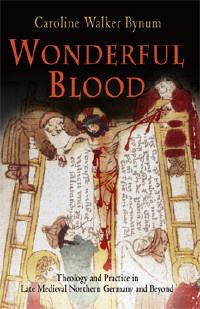Bynum, Caroline.Wonderful Blood:Theology and Practice in Late Medieval Northern Germany and Beyond, University of Pennsylvania Press, 2006.
Bynum這本書主要研究中古末期基督教信徒的思想精神史。自德國北部Wilsnack的寶血信仰(blood piety)出發,追索在中古末期「血」之所以在信仰體系中佔有核心地位的原因與種種神學論辯。Bynum指出「血」是救贖論(soteriology) 的基石,而「犧牲」(sacrifice)則是救贖論之所以可能的解答,因此圍繞著寶血信仰所發展出的,其實是對基督受難的整體細部認知,對中古末期的人 而言,他們其實十分渴求基督的血,他們想像中的血有噴濺狀(blood as poured out)、血滴狀(blood as drops)與泉湧狀(blood as streams)三種,不但象徵救贖,也象徵控訴,不但象徵愛,也象徵罪,不但象徵生命,也象徵死亡。對中古末期的人而言,鮮血雖然代表著上帝的憤怒,但 更重要的是他們可以藉由鮮血獲得救贖,鮮血對他們而言不是血淋淋的、可怕的,而是令他們渴求,常常在冥想中嚮往的。這種對寶血的信仰體系,在1552年 後,新舊教的紛爭中漸漸崩亡了。Bynum採用非常仔細的神學、邏輯論證,讀來令人感到吃力,但也吃驚於其細密。寫作風格是會在每一章不斷回顧已經處理的問題,提示尚待處理的問題,史料跟神學家都不停重複出現,所以很容易加深印象,掌握基本大要,是非常smart的處理方式。
----------

官方介紹:
Wilsnack, a quiet market town in northeastern Germany, is unfamiliar to most English-speakers and even to many modern Germans. Yet in the fifteenth century it was a European pilgrimage site surpassed in importance only by Rome and Santiago de Compostela. The goal of pilgrimage was three miraculous hosts, supposedly discovered in the charred remains of the village church several days after it had been torched by a marauding knight in August 1383. Although the church had been burned and the spot soaked with rain, the hosts were found intact and dry, with a drop of Christ's blood at the center of each.
In Wonderful Blood, Caroline Walker Bynum studies the saving power attributed to Christ's blood at north German cult sites such as Wilsnack, the theological controversy such sites generated, and the hundreds of devotional paintings, poems, and prayers dedicated to Christ's wounds, scourging, and bloody crucifixion. She argues that Christ's blood as both object and symbol was central to late medieval art, literature, pious practice, and theology. As object of veneration, blood provided a focus of intense debate about the nature of matter, body, and God and an occasion for Jewish persecution; as motif, blood became a prominent subject of northern art and a central symbol in the visions of mystics and the prayers of ordinary people.
Bynum contends that the fourteenth- and fifteenth-century concern with the blood of Christ was not a reflection of either superstition or social unrest but, rather, an occasion to explore profound philosophical and religious issues. Wonderful Blood treats the late Middle Ages in northern Europe not as a prelude to the Protestant and Catholic reformations of the sixteenth century but as a period characterized by its own distinctive approach to the question of how humankind gains access to a Christ understood as simultaneously present on earth and gone away into heaven.
----------------
官方作者簡介
Caroline Walker Bynum is Professor of Medieval History at the Institute for Advanced Study in Princeton, New Jersey. A past president of both the American Historical Association and the Medieval Academy of America, she was a MacArthur Fellow from 1986 to 1991. She is the author of several books, including Metamorphosis and Identity, The Resurrection of the Body in Western Christianity, 200-1336, Fragmentation and Redemption: Essays on Gender and the Human Body in Medieval Religion, and Holy Feast and Holy Fast: The Religious Significance of Food to Medieval Women, and is the editor, with Paul Freedman, of Last Things: Eschatology and Apocalypse in the Middle Ages, also published by the University of Pennsylvania Press.
------------------
bought on Apr. 18 2007
readed on Jul. 10 2007, finished on Aug. 09 2007
abstracted on Aug. 11 2007
-----------------
旨彥@新房
2010.01.02

